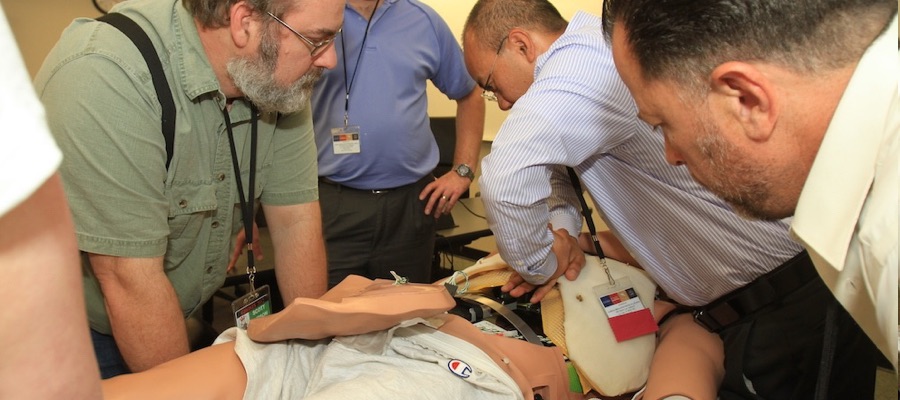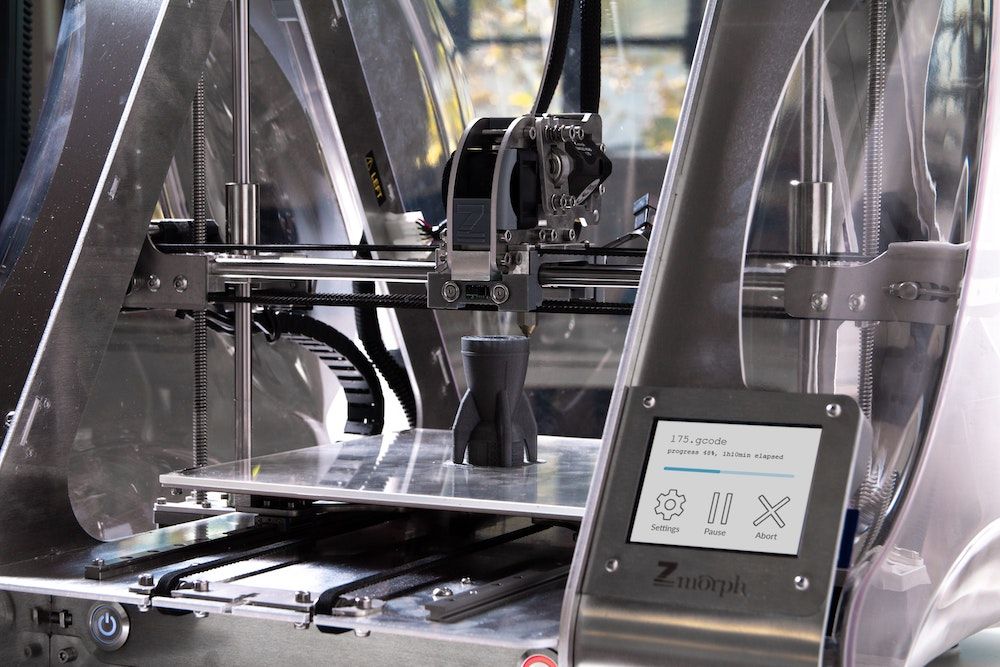Comprehensive Healthcare Simulation: Operations, Technology, and Innovative Practice is the leading medical simulation book for healthcare professionals starting or expanding their use of the emerging methodology to improve learning, training, and patient safety outcomes. From the basic theories to advanced practices, this healthcare simulation book has been praised by readers as a “must read” from leading experts around the world. Here we take a closer look at Part 2 of the book which focuses on Simulation Technology Operations Specialists, starting with a chapter about this new profession of “Sim Tech”. Written by SimGHOSTS Executive Director Kirrian Steer, former Board Member Rachel Bailey, and Dr. Scott B. Crawford, Associate Professor and Director of the Training and Educational Center for Healthcare Simulation at TTUHSC El Paso — the chapter is a perfect primer for any administrator or sim lab coordinator looking to learn more about this unique staff position.
Editors Note: Next month August 4-7 the annual SimGHOSTS 2020 Healthcare Simulation Technology Conference is going virtual! Join hundreds of Simulation Champions from around the world at this “Global Experience” event! The “Gathering of Healthcare Simulation Technology Specialists” will provide a meeting place for those operating simulation technologies to exchange ideas and network with technical peers as well as receive specialized training in the design, selection and application of healthcare simulation technologies. You will also have opportunities to meet with simulation-based vendors to engage with the latest in healthcare education technology — and all from the comfort of your home or office! Learn more and register here now!
Simulation centers have been a part of training healthcare personnel for over a decade. As simulation training methods evolved and diversified, so did the range of technical expertise required to support these methods. The role of the healthcare simulation technology specialist has been created as an industry recognized position to fill the gap between medical knowledge and technical skill to improve the opera- tion and training within simulation centers.
The role of the HSTS in healthcare simulation does not fit into a predefined box by most institutions of higher learning. Many human resource departments still do not have a title or job description to accurately portray the daily activities of this individual. Despite this lack of unified understanding, simulation centers routinely cite lack of support staff as a major barrier to the delivery of simulation education. A survey of simulation center directors presented in 2017 found that more than 75% of the 141 respondents were recruiting or had recently hired an HSTS. This survey also reported that only 1.9% of respondents found many well-qualified candidates in the HSTS applicant pool. Not surprisingly, this same survey found that prior training and experience as an HSTS was the most important feature of a new hire. Increased attention on the development and support of this role has occurred from groups like Gathering of Healthcare Simulation Technology Specialists (SimGHOSTS), Association for Simulated Practice in Healthcare (ASPiH), Society for Simulation in Healthcare (SSH), and the International Nursing Association for Clinical Simulation and Learning (INACSL).
The eight-domain model was created using a modified Delphi method at the SimGHOSTS international conference in 2013. Self-identified individuals working within this profession created pooled descriptions of roles and responsibilities. Following this activity, emails were sent out to 30 individuals who reported expertise in one or more of six initially described content fields:
- Education
- Audio/video
- Information technology
- Medical knowledge
- Theater and stage
- Simulation methodology and practice
The HSTS role has been used often to fill many gaps that may exist within a center. A running joke at simulation technology conferences was to describe job duties with the phrase “other duties as assigned.” This frequent conclusion to a job description was the final catch-all for this role and was often invoked when personnel were asked to create novel experiences or participate in activities outside of their professional scope and background. While the expectations of the HSTS frequently require innovation and self-directed learning, a lack of role delineation and job expectations can lead to early burnout and dissatisfaction within a position.
This discrepancy may exist because of a lack of understanding of the specific need for the position or because of an unrealistic expectation of the ability of a new hire to adapt and fulfill the role. An improved knowledge of what should and should not be expected from this individual will help simulation programs to have a realistic expectation and understanding of how to support and develop individuals, and a better appreciation of the educational and technical background required for those looking to become HSTSs.
An entry-level HSTS requires a high school diploma or equivalent with vocational qualification or health professional certification highly regarded. Examples of relevant qualifications and certifications would be as a medical technician, a clinical assistant, a basic life support instructor, or first responder. An intermediate Healthcare Simulation Technology Specialist would be expected to hold a bachelor-level qualification or equivalent combination of qualification and experience. The qualification is preferred to be from the field of IT, AV, or a health profession. Many programs would accept any field relevant to their program and the specific role to be filled.
The most frequently requested certification was as a life support instructor with the majority of programs requesting at least one of the following certifications: basic life support, advanced life support, pediatric advanced life support, or advanced cardiac life support. The only simulation certification requested in recruitment notices was the Certified Healthcare Simulation Operations Specialist (CHSOS) offered by the Society for Simulation in Healthcare.
The technology in a simulation center extends to the highly specialized field of simulation technology. A healthcare simulation technology specialist requires comprehensive knowledge of the installation, configuration, operation, and trouble- shooting of patient simulators and manikins. Often the HSTS is the only person with a full understanding of the features and operation of a simulation training tool.
They provide technical support for all simulation operations including preparation, maintenance and repair of computerized manikins (software and hardware), task trainers, and multimedia peripherals. Responsibilities extend to the maintenance of simulation technology, which involves the cleaning and servicing of equipment in accordance with appropriate procedures or standards, and coordinating repair of simulation equipment in collaboration with manufacturer technical support.
It is essential for HSTSs to maintain their technical expertise in order to effectively manage simulation equipment and enforce proper usage and operation by all personnel. It is also essential to maintain current knowledge of simulation equipment catalogs and operation manuals to provide recommendations for budgets and purchase of equipment, supplies, and materials related to simulation. These recommendations should be made based on expected utilization and anticipated or proven function of each training tool specific to each simulation program. This ensures not only that the equipment purchased will be suitable for the program and facility but that it will also be compatible with pre-existing equipment and planned program growth.
In order to effectively control a simulation session, the HSTS requires familiarity with common medical equipment and medical procedures and must possess sufficient medical knowledge to envision, implement, and ideally assist with the development of realistic clinical scenarios in consultation with appropriate content experts or educational faculty partners. An HSTS must be able to set up, operate, maintain, and troubleshoot clinical instruments and medical equipment, such as IV pumps, ventilators, and hospital beds. This combined set of skills to oversee and run a clinical scenario may necessitate learning medical terminology, human anatomy/ physiology, healthcare documentation systems, universal precautions, and medical procedures.
Previously We Shared Chapter Excerpts on:
- Professional Development Opportunities
- Types of Healthcare Simulation
- Medical Simulation Methodologies
- Finding the Right Simulation Personnel
- Curriculum Development, Integration, and Operations
- The Research Process
- Simulation Center Design
More Key Take Aways From Latest Simulation Operations Book Include:
- Practical guide helps prepare professionals for the broad scope of simulation in healthcare
- Defines the domains of medical simulation operations
- Focuses on the development of the healthcare simulation technology specialist
- Written and edited by leaders in the field of clinical simulation
Written and edited by leaders in the field, Comprehensive Healthcare Simulation: Operations, Technology, and Innovative Practice is optimized for a variety of learners, including healthcare educators, simulation directors, as well as those looking to pursue a career in simulation operations as healthcare simulation technology specialists. Grab your copy today through our affiliate commissioned links:









